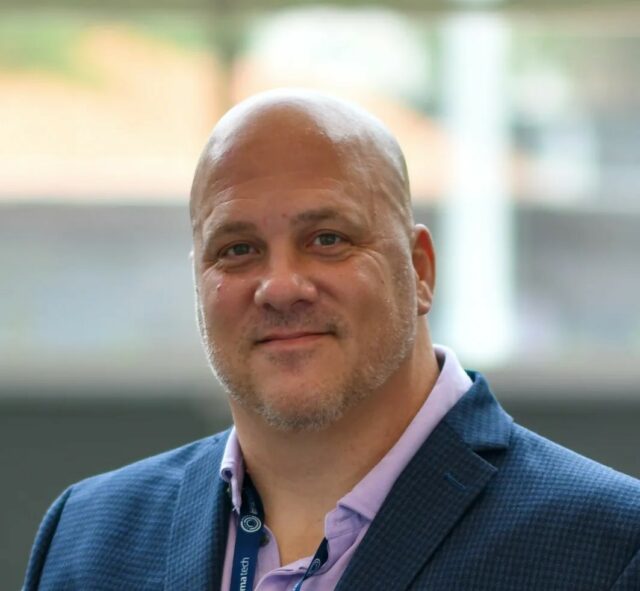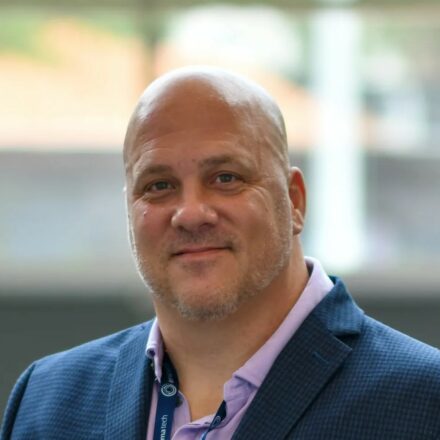Carbon fiber has helped propel humanity forward—literally. The material is used in spaceships, race cars and other high-velocity machines that need to be simultaneously lightweight and seriously durable.
But in materials science circles, carbon fiber has a “dirty little secret,” says Nick Abbatiello Sr., distinguished engineer of sustainable materials and circularity at Dell Technologies. Due to its high-stakes use cases, it’s often considered difficult to recycle or reuse. “Nobody wants to put recycled carbon fiber in an airplane,” explains Abbatiello. “There are obvious safety issues with that.”
But using recycled carbon fiber to make laptops? That’s another story. Computers need to be robust, sure—but not in a hurtling-humans-beyond-the-sound-barrier sense. So in 2013, Abbatiello, who had been tasked with finding a way to produce lighter, thinner notebooks as cost-effectively as possible, proposed using the material in Dell products. Two years later, Dell rolled out their first recycled-carbon-fiber notebooks as part of their Latitude product line.
Today, Abbatiello, who’s now been at Dell for 16 years, is still dreaming up novel solutions to sustainability pain points—and working on ways to keep up momentum.

Making sustainability a priority
The move toward recycled carbon fiber was a “win-win-win,” notes Abbatiello. Not only was the material lightweight, strong and relatively affordable, but it was also sustainable. “We took stuff intended for landfills—scraps coming out of the manufacturing process for aerospace parts—and diverted it and put it into our products,” he says.
Pretty quickly, Abbatiello knew he was onto something—even though sustainability was really more of a bonus versus a priority a decade ago. “We knew [sustainability] would be a trend in the future,” he says. “We realized that if we thought about it from the start, we wouldn’t need to come back to the product design in five years.”
In fact, sustainability would come to define the next decade of Abbatiello’s career—as well as the tech industry at large. Today, according to Dell’s Innovation Index, more than one in three companies view climate change as an innovation accelerator. More than half (52%) of IT decision-makers are working to reduce their overall IT carbon footprint—and 39% are turning to technology to gain greater visibility of their carbon impacts. What’s more, nearly half (47%) of IT decision-makers are retiring or recycling their end-life IT equipment.
At Dell, there’s been a growing emphasis on sustainability in recent years, too. In 2023, it’s one of the company’s core tenets of product design. By 2030, Dell hopes to reuse or recycle an equivalent product for every new product purchase—and the company also aims to make 100% of its packaging from recycled or renewable material.
Mapping the road ahead

Abbatiello is just one of the many experts at Dell working on turning such moonshot goals into realities. In addition to introducing recycled carbon fiber into Dell notebooks, Abbatiello has worked on a wide range of other sustainable materials initiatives.
“In my opinion, no material is ‘good’ or ‘bad’—but there’s always an opportunity to improve,” says Abbatiello. “I don’t like telling designers that they can’t do or use something. Instead, I look at how it can be done or used better.”
For instance, rather than outright discouraging designers from using aluminum —since it’s a high source of carbon emissions—Abbatiello helped spearhead an initiative to switch from traditionally sourced aluminum to hydropower-produced aluminum. Today, this material goes into Dell’s XPS and Latitude product line, and the shift has resulted in a 70% reduction in aluminum-related emissions. “That was a quick win for us on our sustainable materials journey,” says Abbatiello.
But the truth is that “quick wins” aren’t par for the course. Making truly impactful changes involves thinking about the bigger picture, including what an initiative will look like much later down the line.
“Sometimes, it’s hard for us as a big company to move from zero to 100. It becomes a question of, ‘How do we get to 25? To 70?'” says Abbatiello. “We have multi-generational plans from a technology point of view for each material. It’s important to have a clearly articulated vision of where you want to go.”
Initiating ripple effects

Seeing such a vision through to fruition, however, involves a lot of collaboration—and persistence. For example, a couple of years ago, Abbatiello broached the idea of adding biocontent into the plastics used in Dell products. “I kept telling our suppliers, ‘We need to be thinking about how to make renewable, bio-based content,'” he recalls. Eventually, this point hit home—but only after evidence of industry-wide interest. “One of our suppliers finally said, ‘You know what, we’ve now got five companies asking for this. So, we’re willing to put the resources toward making it happen,'” he says. “It’s just one example of the fact that while we’re a huge company, we’re not big enough on our own to drive significant change. It’s all about the supply chain and awareness.”
Once put in motion, however, even an initially small ripple can make waves—which is why Dell’s role as a catalyst is so important. “Someone’s got to be the first person to dip their toe in the water,” says Abbatiello, circling back to the carbon fiber example. “There wasn’t a recycled carbon fiber industry ten years ago—it didn’t exist. But now, there’s more than one global company recycling carbon fiber. Dell helped create that demand.”
When it comes to how a field like sustainable materials can have its own ripple effect, Abbatiello sees a clear connection. “People tend to think about circularity and climate as separate, but I see them as two sides of the same coin… If I can reuse materials and avoid mining and extraction, I’m reducing carbon emissions,” he says, adding that the more companies who recognize this, the better for us all. “This is not a competition. This has got to be all of us all in, doing the right thing, sharing our learnings and innovations, so that we as an industry can move the needle in the right direction.”
To learn more about Nick and sustainability at Dell, watch the video below.
Innovators at Work is a series on Perspectives profiling Dell team members who drive innovation by combining ideas and technology to create life-shaping impact. The series is inspired by Dell’s Innovation Index, which provides insight on what global decision makers are doing to create innovation resilience in turbulent times.

